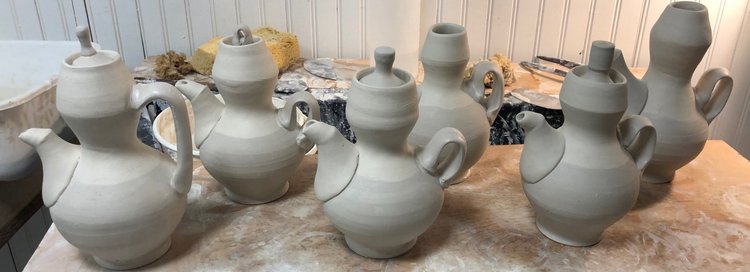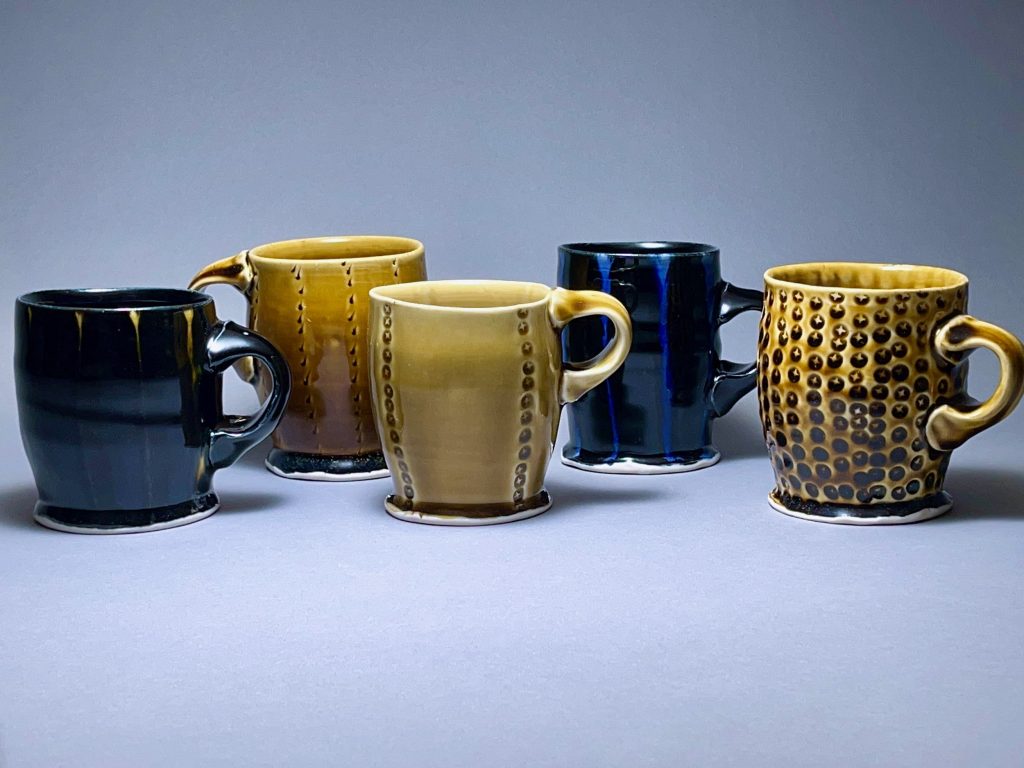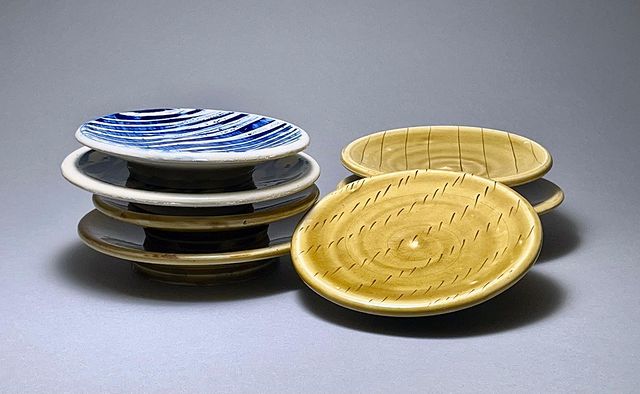Avisen Legal’s Jeremy Kalin is a man of many talents whose journey intertwines law, public service, and the intricate art of pottery. As a dedicated attorney and a former elected official, Jeremy’s belief in creative collaboration shapes his work as a potter and as a lawyer, mobilizing capital for public good and advancing sustainability.
In this interview, we delve into a lesser-known aspect of Jeremy’s life: his passion for pottery. Despite his demanding work as a lawyer, Jeremy finds energy and personal inspiration via tactile practice in the clay studio. Join us as we explore how Jeremy’s creativity in pottery mirrors his approach to law, offering insights into resilience, problem-solving, and the parallel pursuit of passions.
 Can you tell me about your journey into pottery? What initially sparked your interest in this craft?
Can you tell me about your journey into pottery? What initially sparked your interest in this craft?
I was kind of a lost soul as a teenager, but I was lucky enough to go to Minneapolis South High School. Of all places in the world, this diverse inner-city high school hosted a full-time ceramics program. I pleaded to get in as a sophomore — it’s a very popular class. So, it was the winter of my sophomore year and a phenomenal teacher named John Kantar made this ceramics class a great, safe place to explore, to learn, and to be challenged. He set it up as very similar to a university or higher-ed art center.
I actually didn’t like it at first because he had us start with slab building, hand built objects, and then coil pots. And it just did not interest me.
Then I started throwing on the wheel and it was like, boom, I’m a potter. This immediately became something I was really interested in. And one of the things that John did was expose us to the tradition of potters throughout history as well as to contemporary potters.
There was something captivating for me about making something both beautiful and useful, on top of the challenge of learning a craft. I’ve felt lucky to have that experience and have him as a mentor and father figure at the right time in my life.
Could you describe your creative process when you’re working on pottery? Do you have any favorite techniques, styles, or things that you do to put yourself in the right headspace?
Well, there’s two pathways. One is, I’m constantly surrounded by handmade pots, some by my friends and people I know, some by people I’ve grown to like and admire, but never met. So, I’m constantly enjoying other people’s work.
But I’m also thinking about the usefulness of a piece. I love to cook, and I love to eat. When I use olive oil, I realized that a commercial olive oil bottle does not pour very well for drizzling olive oil on pizza fresh from the oven. So, having a little ewer with the right spout that pours the right way, I start thinking “how can I make that work well?”
One of my big rituals is morning coffee. I use the pour-over method. The pitcher that I use for my coffee is a pot by my friend Joe from Utah, made in 1995 or so, but it doesn’t have a lid. That made me think, “well, I’ve never made coffee pots with lids. God forbid that one breaks….” so I started making lidded pitchers.
Then there’s always just personal preference. With mugs, for instance, I’m a small handle mug person, but my wife is a full-hand handle mug person. And she likes big cups. I like small ones. Part of creating is constantly talking to people about what they like and getting their feedback.
The other part of the creative process, and this is so similar to practicing law, but you just have to get started, right? There’s nothing worse than having a to-do list and knowing that you have something to do, but not knowing how to start.
For instance, I’m working on a solar option for a client to lease the roof, once the buyer closes on the sale, which could happen this summer or might not happen for a while. I was just sitting there going, how do I get this thing done? Well, you just start with a document. Sometimes it’s a blank document. Sometimes it’s looking at something you’ve created in the past.
In the clay studio, it’s a similar process of just getting your hands dirty. Just go put on the apron and get started. I set aside Wednesday and Friday mornings as holds to work on pottery. I try to just go downstairs as soon as the kids leave for school, get in the studio, and just start doing something – whether it’s processing some clay to be recycled and reused, or whether it’s doing some glaze tests – just do something to get that momentum going. Once it’s going, then the hands and the body just kind of take over in a really lovely way.
 You mentioned your studio. Tell us about your studio.
You mentioned your studio. Tell us about your studio.
I used to fire my pots in a wood kiln, very much a country potter, and I really loved the direct interaction of flame to the pots. But that was when I lived out in the country, and I don’t anymore.
Now, I’m a city potter. As I was getting ready to start making pots again, my country potter friends invited me to come out and fire with them. And that was tempting. But, you know, it’s an hour drive each way, and I stress about being a good steward of someone else’s kiln. Plus, I like being self-sufficient.
So, I took over the old coal storage basement room of our house built in 1915. It’s actually the largest studio I’ve ever had. I’ve got my wheel and a couple of tables, a wedging table and some shelving. Then, off of that is a very small room where I have my storage for all of my finished pots that are waiting to be glazed and fired.
The only thing I don’t love is that I have to take my fully dried pots, and they’re very fragile at that point, on boards up the stairs, through our mudroom, and out to the garage where the electric kiln is. Especially in the winter, that’s not always easy.
I feel really lucky to have this space in my basement, especially when I’m working from home and I have pots that are drying. Making pottery is very much about timing. Once you’ve thrown it, then if you’re going to turn it over and trim the bottom, you want it to be stiff enough. We call it leather hard. You want it to be stiff enough so you can turn a bowl upside down, but not so hard that it’s almost dried out because it can also crack or even break. A half hour can make the difference between being dry enough or too dry. I’m constantly, three, four, five times a day, just going down for 30 seconds and checking on a board of pots. Once ready, I’ll either put them under plastic, or I’m soon going to make these so-called damp boxes that make it even easier to keep it at the right moisture level.
Have you faced any challenges or setbacks in your pottery endeavors, and if so, how have you overcome them?
The art of pottery is the art of failing, and failing often. I could describe for you 10,000 different times when something went wrong in the process of making pots. I think everyone who’s touched a potter’s wheel is familiar with throwing a pot and having it collapse.
I like forms that have some life to them, either full bellies or very tall or something that’s presenting a little bit of tension. With these larger pieces, in the drying process, things can crack.
In the first firing, called the bisque firing, things can even blow up and I’ve had that happen too many times to admit. Or your glazes could fit, not fit, crawl, or come out a different color or texture. Sometimes your kiln doesn’t shut off at the right time or the kiln doesn’t make it all the way to temperature, you name it.
The firing process happens in a visual vacuum. So, you fire and then you wait a day or two and then you open the kiln and it’s like Christmas or Hanukkah. It’s a bit of a surprise how things will turn out.
Even after things are fired, you can get what’s called a lime pop, and these might not happen for weeks or months. I have a plate that I made in 2001, a really lovely dinner plate that I like a lot, and just last year, a pop showed up in it.
You just get used to failing. The only thing you can do is just keep trying and keep getting ahead of it. I feel really fortunate for all the failures I have under my belt because it makes it easier to get back to it and try again.
It’s very similar to my law career. Obviously, we try not to fail as lawyers, but we make mistakes from time to time. It’s much easier to say, “I tried my best. I read through this three times. I thought about this. I didn’t over-promise or over-commit my knowledge base, but I missed something. Thank you for catching that. Thank goodness this is caught now. Let’s fix it.”
You get comfortable with understanding that none of us are perfect. I used to have it on a board in my law office: “We’re striving for excellence, not perfection.”
How do you feel your pottery practice has evolved over time? What are some of the highlights, and what have you learned from the experience?
It’s been so interesting to get back to it, because I’m coming with fresh hands and fresh eyes. The last time I made pots on a regular basis was 15 years ago, so my body’s different too.
When I was a working potter in my twenties, and that’s largely how I made my living, it was all wood-fired pots where the flame would directly interact with the pots. Then, at the end of the firing, we’d throw in salt – just rock salt or table salt – and it would explode to go from a solid to a gas immediately. The sodium combines with the silica and the clay to make this glaze. When that happens, the fire side gets blasted with more activity than the quieter backside. You have these dramatic surfaces, and I can almost paint with the flame when I was stacking the kiln.
Well, now I fire in an electric kiln that’s truly a glorified toaster oven. There’s no flame, just resistance heat. It’s clean as a whistle. It’s just so different.
When I came back to pottery, I took a year of making test tiles, testing glazes and very small objects because I needed to understand this new electric kiln and process. Now that I have a small palette of glazes that I like, as soon as I’m picking up clay and preparing to throw, I already start seeing a form in mind.
Whether I make it a smooth surface or leave tool marks so the glaze can cool and ripple, all that’s important for me is visualizing the product all the way through the process. It’s similar to starting a project with a client in the clean energy space. All these pieces that we’re putting together about who’s going to own the system, where the financing is going to come from, who’s going to build it, who’s going to benefit from it, what’s it going to look like.
When you start, you’re trying to control this uncontrollable process almost. Now it’s much more methodical and simpler, but it’s still a whole new adventure for me.
The other thing I noticed is I thought I was in this rustic folk craft tradition. Now, I just decorate the heck out of things. I love Islamic patterns. I love old fabric patterns. I love seeing the patterns of different layers of snow on shingles or on pavers. In that same way, I love the texture on pots.
Right now, I’m using the heads of screws as design elements. When you just push it into the clay, it makes a little stamp, and a Phillips head looks different than a square head, which looks different than a slot head. It’s fun. The 22-year-old folk craft potter version of Jeremy wants to have a word about how colorful and decorated my pots are now.
We’ve started to talk about this a little bit: do you see any connections between your work in pottery and your legal practice? If so, could you elaborate on that?
Some similarities are simple. I care about how my documents look. I care about the balance of white space to print. I care about how easy it is for people to read. And I feel like the same is true, certainly for me, in terms of objects, like cups, bowls, and teapots.
People can perceive whether or not there is a whole lot of blank space or if there’s all this dense language in here. I want a document to read clearly: this is a solar roof lease. Using plain language that says why we’re doing this. That’s one piece of it.
I sold my pots retail – at art fairs, at other people’s sales and at my own studio sales. In doing that, I had to learn how to talk about my pottery and tell that story in a simple, understandable way. I’ve been constantly asking my legal clients to tell me, why are you doing what you’re doing? What are you trying to achieve? Then, let’s put that story in. Let’s make sure that these documents tell your story all the way through.
There are more legally sophisticated or complex provisions we include, like for instance indemnification clauses. Well, an indemnification clause just says, “What happens if something goes wrong?” How can we explain and walk through those pieces?
I’m constantly teaching, even as a lawyer with my clients, because I did some pottery teaching as well and was actually a pretty good teacher of how to throw and how to make pieces. That’s definitely a part of the similarities too.
Then there’s the creative process. I love digging into the tax code, figuring out how do we bring in all these resources that typically are available? The tax code has been written for wealthy people and thankfully, the Inflation Reduction Act really changed key parts of the tax code for the better, particularly for energy projects, solar, and energy storage. I’m constantly working together with my clients to figure out what are some new structures and new vessels for ownership for community benefit. It’s a big creative exercise.
The whiteboard in my law office gets filled up and erased and filled up and erased and captured and then redone because we’re constantly trying to figure out what’s the best and most efficient way to maximize the community benefits and the opportunities. I just love that creative side of law. It’s awesome.
Along those lines, in what ways do you think your involvement in pottery has influenced your approach to problem-solving or creativity in your legal work?
It’s given me this confidence knowing I have solved lots of weird problems. Some of them happen while I’m on the roof of a shed and trying to put out a fire at two o’clock in the morning. Some of them are from thinking “I liked this teapot, but that is a terrible spout!”
Take those coffee pots I was talking about. Two of them I made a certain way and then I made a board of four of them recently. On two of them, the spouts just came off when I was in the process of trimming the feet.
I’ll have these objects I really like, except there’s this big gnarly hole. What am I going to do? Then I remember, I used to like attaching separate spouts. So I can just make a spout out of a slab and form it and attach it. And it looks great. They’re really beautiful and elegant, if I can say so.
That happens a lot. I’ll finish a legal document and hand it over to the client and the client would say, “Can we do this slightly differently depending on what happens, who’s responsible for ownership and maintenance long-term?” But if we change that, then we’ll have to adjust some other parts of the agreements.
I’ve learned how to adjust things in the middle of the process, to make things better or to fix small errors. I wish I could tell you that I did perfect work every time for every document, but that’s not how life works – at least for most people I know.
Just like in the pottery studio where I focus on one shape or type of pot for a long while, in my law practice I tend to work with lots of similar clients, working in similar spaces, like nonprofits helping develop solar for themselves or for their constituents. This helps me go even deeper in solving difficult challenges. For instance, in a nearly worst-case scenario, when the IRS came out with a rule that totally obliterated a structure that we’ve been working on for a client for at least a year, I reassured the client that we’d figure out some way of moving forward, though I wasn’t sure yet exactly how. I knew that I had solved a problem like this before, but I was so stressed about it. I just had to talk myself down from being tense and just stay relaxed, reminding myself that I’ve solved similar problems before.
I knew that I wasn’t just talking about legal problems. I knew that I’d solved this in lots of ways, whether it’s parenting, coaching, or teaching pottery. Then, at four o’clock in the morning, I remembered that one state structured their program a specific way, one that actually sidesteps all these limitations the IRS just put out.
Now, my client’s in good shape, and it was such a relief to finally get to that solution. I’ve been there, and I was able to figure it out. Yet again.
What advice would you offer to other professionals who are interested in pursuing creative hobbies alongside their careers? Could you share any insights on the benefits of engaging in creative activities like pottery for individuals in demanding professions?
One big step for me was to just make the time. My goal has never been to bill 2,000 lawyer hours a year and just make gobs and gobs of money. My goal is to make a difference for people, to be of service, and try to make the world a better place.
Right now is the moment for climate finance, climate investment, and solar, but I realized if I set aside a couple mornings a week, just some specific time, that clears my mind to focus on my law work. I’m good at keeping that discipline. Last Friday I didn’t get in the studio, and I could tell from my mood.
I felt good about having checked off a lot of the legal to-do list, but my body felt like it was missing something. Not even from the standpoint of physical exercise… I just needed that outlet. So, I would say to others: be sure to make that time.
I think a lot of people, especially lawyers, accountants, and professional service people, feel like they have to keep working and working and working. I realized that my creative practice feeds my professional practice. Cut yourself some slack, then build a community that is outside of your professional world. My close group of potter friends keeps me grounded, keeps me laughing, keeps me challenged, and keeps me inspired.
 Where can people see or purchase your pottery?
Where can people see or purchase your pottery?
You can go to jeremy-kalin.com or my Insta handle is @jeremy.kalin to see a little of my story.
On the website, people can see a gallery of work throughout time. You can buy pots online there too at The Store. I even have a discounted area called The Cellar where you can buy things that have glaze issues or my oldies, but goodies.
On Instagram, I try to include some process videos or a lot of pictures of things in process. Those coffee pots I was talking about, you can see a little bit of how they got made. I like showing my struggles there too.
To learn more about Jeremy Kalin’s legal work, explore his attorney biography and recent articles on the Avisen site. Meet the rest of the Avisen team here. To see or purchase Jeremy’s pottery, head to jeremy-kalin.com or follow him on Instagram.





